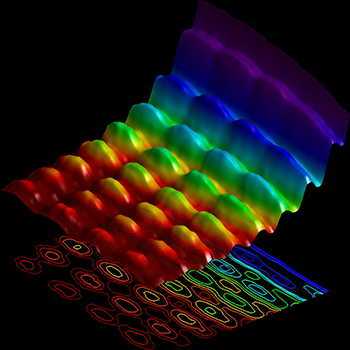
Visualization of the wave-particle dual nature of light: Waves run from top left to bottom right; the particle nature is perpendicular to the waves. Credit: Fabrizio Carbone, EPFL
Ever since Louis de Broglie proposed the wave nature of matter in the 1920s, countless physics students have tried to picture wave-particle duality. Thanks to modern electron microscopy techniques, scientists based in Switzerland have captured the first image of light exhibiting both properties simultaneously (Nat. Commun., doi:10.1038/ncomms7407).
To accomplish this feat, physicist Fabrizio Carbone and his colleagues at the École Polytechnique Fédérale de Lausanne (EPFL) in Switzerland confined light into a tiny space through the excitation of surface plasmon polaritons. A technique developed over the past decade, photon-induced near-field electron microscopy allows researchers to control such polaritons and record their behavior in the spatial and temporal domains.
With a strong femtosecond laser pulse at a wavelength of 800 nm, Carbone's team induced a surface-plasmon-polariton standing wave on a silver wire with a radius of roughly 50 to 60 nm, isolated on a grid covered with graphene for heat dissipation. The light and probing electron pulses (the latter from a thermionic electron gun) overlapped along the tiny wire.
The team imaged only the electrons that gained energy from interaction with the photons and captured the resulting plasmonic field with femtosecond resolution. Tuning the polarization of the excitation light pulses allowed the scientists to control the spatial interference pattern of the standing wave.
The resulting energy-space map, as interpreted with finite-element simulations, showed both wave and particle aspects of the surface plasmon polaritons simultaneously. Previous experiments had demonstrated the polaritons' wave and particle behavior in separate measurements.
